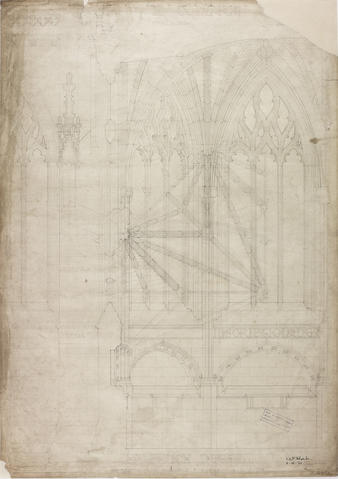License:
 This image is provided under a Creative Commons BY-NC-SA License. You can download this version for private study or non-commercial use. Our terms, conditions and copyright policy (PDF) contains further information about acceptable usage. If you are seeking permission to publish, please contact us ›
This image is provided under a Creative Commons BY-NC-SA License. You can download this version for private study or non-commercial use. Our terms, conditions and copyright policy (PDF) contains further information about acceptable usage. If you are seeking permission to publish, please contact us ›
Please click here if you would like to request a larger, high-resolution version ›
Key Information
Reference code
Title
Date(s)
- 1922 (Creation)
Level of description
Item
Extent
1
Content and Structure
Scope and content
Detail of window tracery.
Appraisal, destruction and scheduling
Accruals
System of arrangement
General Information
Name of creator
Biographical history
George Ferguson Smellie Shanks was born at Partick on 15 May 1898, the son of George Ferguson Smellie Shanks, engine patternmaker and his wife Eliza Jane Borthwick. In July 1915 he began as an articled pupil with Honeyman & Keppie while attending classes in building construction. In September 1916 he started the architecture course at the Glasgow School of Art. However his studies were interrupted when he was called up in World War 1 and from December 1916 to January 1919 he served with HM Forces in the United Kingdom, Palestine and France. After demobilisation he returned to Honeyman & Keppie’ s office and resumed his studies at the Glasgow School of Art and the Royal Technical College. He completed his apprenticeship in January 1921, remaining with Honeyman & Keppie as assistant. In March 1923 he moved to a similar post with Wright & Wylie, being promoted to chief assistant in March 1924. He was awarded his diploma in January 1924 and was elected ARIBA on 5 January 1925, his proposers being Andrew Graham Henderson John Watson and John Keppie. Shanks had travelled widely by the time of his election to Associateship. During the war he had visited France, Italy, Egypt and Palestine. In 1921 he visited Oxford and London, in 1922 Winchester, York & Durham and in 1924 Canterbury and Liverpool. In 1923 he had been awarded the Bowden Travelling Scholarship from the School of Architecture and in 1924 the John Keppie Travelling Scholarship. This enabled him to spend two weeks in Paris and four weeks in Italy in 1925 visiting Genoa, Pisa Lucca, Rome, Naples, Siena, Florence, Bologna, Ravenna, Venice, Vicenza, Verona and Milan. Shanks remained with Wright & Wylie which became Wylie Wright & Wylie in 1928 after Frederick Robert Wylie joined as partner and after Wright withdrew in 1935, Shanks became a partner, the practice title becoming Wylie Shanks & Wylie. By 1939 Shanks had become a Fellow of the Glasgow Institute of Architects and in 1947 FRIBA, proposed by George Arthur Boswall, Andrew Graham Henderson and Thomas Johnston Beveridge. In 1946 Walter Underwood was taken into partnership, but the firm name was not changed to Wylie, Shanks & Underwood until sometime between October 1956 and April 1957. Underwood left in 1960 and the practice title then became Wylie Shanks & Partners. Shanks retired in 1963. He died of heart disease on 2 August 1985 at Crosshouse Hospital, Kilmarnock. He was survived by his wife Jeannie Ritchie Kennedy.
Archival history
Custodial history
Physical Description and Conditions of Use
Conditions governing access
Conditions governing reproduction
Language of material
Script of material
Language and script notes
Physical Description
pencil on paper
Dimensions: 769 x 545 mm
Finding aids
Related Material
Existence and location of originals
Existence and location of copies
Related materials
Notes area
Alternative identifier(s)
Keywords/Tags
Subjects
Place access points
People and Organisations
Genre access points
Status
Level of detail
Processing information
Language(s)
Script(s)
Sources
Digitised item metadata
Filename
NMC_0334.jpg
Latitude
Longitude
Media type
Image
Mime-type
image/jpeg


